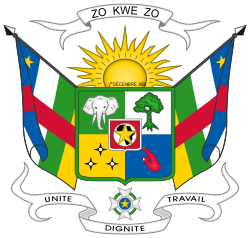History of the Central African Republic
The history of the Central African Republic is roughly composed of four distinct periods. The earliest period of settlement began around 10,000 years ago when nomadic people first began to settle, farm and fish in the region. The next period began around 1,000 to 3,000 years ago when several non-indigenous groups began to migrate into the region from other parts of the continent. The third period involved the colonial conquest and rule of the country by France and Germany which spanned from the late 1800s until 1960 when the Central African Republic became an independent state. The final period has been the era during which the Central African Republic has been an independent state.
Part of a series on the |
|---|
|
 |
|
Early history
|
|
Colonial period
|
|
Independence
|
|
Current period
|
|
Early history
Approximately 10,000 years ago, desertification forced hunter-gatherer societies south into the Sahel regions of northern Central Africa, where some groups settled and began farming as part of the Neolithic Revolution.[1] Initial farming of white yam progressed into millet and sorghum, and then later the domestication of African oil palm improved the groups' nutrition and allowed for expansion of the local populations.[2] Bananas arrived in the region and added an important source of carbohydrates to the diet; they were also used in the production of alcohol. This Agricultural Revolution, combined with a "Fish-stew Revolution", in which fishing began to take place, and the use of boats, allowed for the transportation of goods. Products were often moved in ceramic pots, which are the first known examples of artistic expression from the region's inhabitants.[1]
The Bouar Megaliths in the western region of the country indicate an advanced level of habitation dating back to the very late Neolithic Era (c. 3500-2700 BC).[3][4] Ironworking arrived in the region by around 1000 BC, likely from early Bantu cultures in what is today southeast Nigeria and/or Cameroon.[5] The site of Gbabiri (in the Central African Republic) has yielded evidence of iron metallurgy, from a reduction furnace and blacksmith workshop; with earliest dates of 896-773 BC and 907-796 BC respectively.[6] Some earlier iron metallurgy dates of 2,000 BC from the site of Oboui (also in the Central Africa Republic) have also been proposed,[7][8] but these are disputed by some archaeologists.[9]
During the Bantu Migrations from about 1000 BC to AD 1000, Ubangian-speaking people spread eastward from Cameroon to Sudan, Bantu-speaking people settled in the southwestern regions of the CAR, and Central Sudanic-speaking people settled along the Ubangi River in what is today Central and East CAR.
Production of copper, salt, dried fish, and textiles dominated the economic trade in the Central African region.[10]
The territory of modern Central African Republic is known to have been settled from at least the 7th century [11] on by overlapping empires, including the Kanem-Bornu, Ouaddai, Baguirmi, and Dafour groups based on the Lake Chad region and along the Upper Nile.
Early modern history
During the 16th and 17th centuries Muslim slave traders began to raid the region and their captives were shipped to the Mediterranean coast, Europe, Arabia, the Western Hemisphere, or to the slave ports and factories along the West African coast.[12] The Bobangi people became major slave traders and sold their captives to the Americas using the Ubangi river to reach the coast.[13] During the 18th century Bandia-Nzakara peoples established the Bangassou Kingdom along the Ubangi river.[12]
Population migration in the 18th and 19th centuries brought new migrants into the area, including the Zande, Banda, and Baya-Mandjia.[14][15]
Colonial period
In 1875, the Sudanese sultan Rabih az-Zubayr governed Upper-Oubangui, which included present-day CAR. Europeans, primarily the French, German, and Belgians, arrived in the area in 1885. The French consolidated their legal claim to the area through an 1887 convention with Congo Free State, which granted France possession of the right bank of the Oubangui River. Two years later, the French established an outpost at Bangui, and in 1894, Oubangui-Chari became a French territory. However, the French did not consolidate their control over the area until 1903, after having defeated the forces of Rabih in the battle of Kousséri, and established colonial administration throughout the territory. In 1906, the Oubangui-Chari territory was united with the Chad colony; in 1910, it became one of the four territories of the Federation of French Equatorial Africa (AEF), along with Chad, Middle Congo, and Gabon. The next thirty years were marked by mostly small scale revolts against French rule and the development of a plantation-style economy. The largest of these revolts was the Kongo-Wara rebellion, when over 350,000 natives rebelled against the colonial administration.
The European penetration of Central African territory began in the late 19th century during the Scramble for Africa.[16] Count Savorgnan de Brazza established the French Congo and sent expeditions up the Ubangi River from Brazzaville in an effort to expand France's claims to territory in Central Africa. Belgium, Germany, and the United Kingdom also competed to establish their claims to territory in the region.
In 1889, the French established a post on the Ubangi River at Bangui. In 1890–91, de Brazza sent expeditions up the Sangha River, in what is now south-western CAR, up the center of the Ubangi basin toward Lake Chad, and eastward along the Ubangi River toward the Nile, with the intention of expanding the borders of the French Congo to link up the other French territories in Africa. In 1894, the French Congo's borders with Leopold II of Belgium's Congo Free State and German Cameroon were fixed by diplomatic agreements. In 1899, the French Congo's border with Sudan was fixed along the Congo-Nile divide. This situation left France without her much coveted outlet on the Nile.
Once European negotiators had agreed upon the borders of the French Congo, France had to decide how to pay for the costly occupation, administration, and development of the territory it had acquired. The reported financial successes of Leopold II's concessionary companies in the Congo Free State convinced the French government to grant 17 private companies large concessions in the Ubangi-Shari region in 1899. In return for the right to exploit these lands by buying local products and selling European goods, the companies promised to pay rent to France and to promote the development of their concessions. The companies employed European and African agents who frequently used brutal methods to force the natives to labor.
At the same time, the French colonial administration began to force the local population to pay taxes and to provide the state with free labor. The companies and the French administration at times collaborated in forcing the Central Africans to work for them. Some French officials reported abuses committed by private company militias, and their own colonial colleagues and troops, but efforts to hold these people accountable almost invariably failed. When any news of atrocities committed against Central Africans reached France and caused an outcry, investigations were undertaken and some feeble attempts at reform were made, but the situation on the ground in Ubangi-Shari remained virtually unchanged.
During the first decade of French colonial rule, from about 1900 to 1910, the rulers of the Ubangi-Shari region increased both their slave-raiding activities and the selling of local produce to Europe. They took advantage of their treaties with the French to procure more weapons, which were used to capture more slaves: much of the eastern half of Ubangi-Shari was depopulated as a result of slave-trading by local rulers during the first decade of colonial rule. After the power of local African rulers was destroyed by the French, slave raiding greatly diminished.
In 1911, the Sangha and Lobaye basins were ceded to Germany as part of an agreement which gave France a free hand in Morocco. Western Ubangi-Shari remained under German rule until World War I, after which France again annexed the territory using Central African troops.
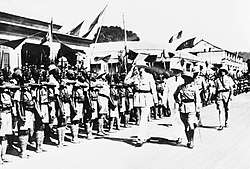
From 1920 to 1930, a network of roads was built, cash crops were promoted and mobile health services were formed to combat sleeping sickness. Protestant missions were established in different parts of the country. New forms of forced labor were also introduced, however, as the French conscripted large numbers of Ubangians to work on the Congo-Ocean Railway; many of these recruits died of exhaustion and illness as a result of the poor conditions.
In 1925, the French writer André Gide published Voyage au Congo, in which he described the alarming consequences of conscription for the Congo-Ocean railroad. He exposed the continuing atrocities committed against Central Africans in Western Ubangi-Shari by such employers as the Forestry Company of Sangha-Ubangi. In 1928, a major insurrection, the Kongo-Wara rebellion or 'war of the hoe handle', broke out in Western Ubangi-Shari and continued for several years. The extent of this insurrection, which was perhaps the largest anti-colonial rebellion in Africa during the interwar years, was carefully hidden from the French public because it provided evidence of strong opposition to French colonial rule and forced labor.
During the 1930s, cotton, tea, and coffee emerged as important cash crops in Ubangi-Shari and the mining of diamonds and gold began in earnest. Several cotton companies were granted purchasing monopolies over large areas of cotton production and were able to fix the prices paid to cultivators, which assured profits for their shareholders. In September 1940, during the Second World War, pro-Gaullist French officers took control of Ubangi-Shari.[17]
In August 1940, the territory responded, with the rest of the AEF, to the call from General Charles de Gaulle to fight for Free France. After World War II, the French Constitution of 1946 inaugurated the first of a series of reforms that led eventually to complete independence for all French territories in western and equatorial Africa. In 1946, all AEF inhabitants were granted French citizenship and allowed to establish local assemblies. The assembly in CAR was led by Barthélemy Boganda, a Catholic priest who also was known for his forthright statements in the French Assembly on the need for African emancipation. In 1956 French legislation eliminated certain voting inequalities and provided for the creation of some organs of self-government in each territory.
The French constitutional referendum of September 1958 dissolved the AEF, and on 1 December of the same year the Assembly declared the birth of the autonomous Central African Republic with Boganda as head of government. Boganda ruled until his death in a plane crash on 29 March 1959. His cousin, David Dacko, replaced him as head of Government. On 12 July 1960 France agreed to the Central African Republic becoming fully independent.[18] On 13 August 1960 the Central African Republic became an independent country and David Dacko became its first President.
Independence
Central African Empire
On 1 January 1966, following a swift and almost bloodless overnight coup, Colonel Jean-Bédel Bokassa assumed power as president of the Republic. Bokassa abolished the constitution of 1959, dissolved the National Assembly, and issued a decree that placed all legislative and executive powers in the hands of the president. On the 4 March 1972, Bokassa's presidency was extended to a life term. On 4 December 1976, the republic became a monarchy – the Central African Empire – with the promulgation of the imperial constitution and the coronation of the president as Emperor Bokassa I. His authoritarian regime was characterized by numerous human rights violations.
Dacko
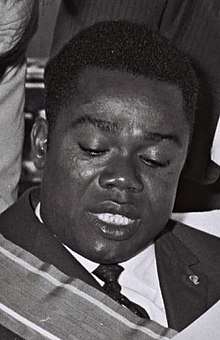
On 20 September 1979, Dacko, with French support, led a bloodless coup that overthrew Bokassa while he was out of the country. The republic was restored, and Bokassa, who took refuge in Ivory Coast and France, was sentenced to death in absentia for various crimes, including cannibalism. Moreover, an African judicial commission reported that he had "almost certainly" taken part in the massacre of some 100 children for refusing to wear the compulsory school uniforms. In January 1981, six of his supporters, including two sons-in-law, were executed. Bokassa returned unexpectedly in October 1986 and on 12 June 1987, he was convicted of having ordered the murders of at least 20 prisoners and the arrest of the schoolchildren who were murdered. He was sentenced to death, but this was commuted to a life term in February 1988. He was released from prison on 1 September 1993, as a result of an amnesty and died of a heart attack in Bangui on 3 November 1996 at age 75.
Kolingba
Dacko's efforts to promote economic and political reforms proved ineffectual, and on 20 September 1981, he in turn was overthrown in a bloodless coup by General André Kolingba. For four years, Kolingba led the country as head of the Military Committee for National Recovery (CRMN).
Kolingba suspended the constitution and ruled with a military junta until 1985. In 1985, the CRMN was dissolved, and Kolingba named a new cabinet with increased civilian participation, signaling the start of a return to civilian rule. The process of democratization quickened in 1986 with the creation of a new political party, the Rassemblement Démocratique Centrafricain (RDC), and the drafting of a new constitution that subsequently was ratified in a national referendum. General Kolingba was sworn in as constitutional President on 29 November 1986. The constitution established a National Assembly made up of 52 elected deputies, elected in July 1987 and municipal elections were held in 1988. Kolingba's two major political opponents, Abel Goumba and Ange-Félix Patassé, boycotted these elections because their parties were not allowed to participate.
By 1990, inspired by the fall of the Berlin Wall, a pro-democracy movement became very active. In May 1990, a letter signed by 253 prominent citizens asked for the convocation of a National Conference, but Kolingba refused this request and instead detained several opponents. Pressure from the United States, France, and from a group of locally represented countries and agencies called GIBAFOR (France, the US, Germany, Japan, the EU, the World Bank, and the UN) finally led Kolingba to agree, in principle, to hold free elections in October 1992 with help from the UN Office of Electoral Affairs.
After using the excuse of alleged irregularities to suspend the results of the elections as a pretext for holding on to power, President Kolingba came under intense pressure from GIBAFOR to establish a "Conseil National Politique Provisoire de la République" (Provisional National Political Council, CNPPR) and to set up a "Mixed Electoral Commission", which included representatives from all political parties.
Patassé
When elections were finally held in 1993, again with the help of the international community, Ange-Félix Patassé led in the first round and Kolingba came in fourth behind Abel Goumba and David Dacko. In the second round, Patassé won 53% of the vote while Goumba won 45.6%. Most of Patassé's support came from Gbaya, Kare, and Kaba voters in seven heavily populated prefectures in the northwest while Goumba's support came largely from ten less-populated prefectures in the south and east. Furthermore, Patassé's party, the Mouvement pour la Libération du Peuple Centrafricain (MLPC) or Movement for the Liberation of the Central African People, gained a simple but not an absolute majority of seats in parliament, which meant Patassé's party required coalition partners.
Patassé relieved former President Kolingba of his military rank of general in March 1994 and then charged several former ministers with various crimes. Patassé also removed many Yakoma from important, lucrative posts in the government. Two hundred predominantly Yakoma members of the presidential guard were also dismissed or reassigned to the army. Kolingba's RDC loudly proclaimed that Patassé's government was conducting a "witch hunt" against the Yakoma.
A new constitution was approved on 28 December 1994 and promulgated on 14 January 1995, but this constitution, like those before it, did not have much impact on the country's politics. In 1996–1997, reflecting steadily decreasing public confidence in the government's erratic behaviour, three mutinies against Patassé's administration were accompanied by widespread destruction of property and heightened ethnic tension. On 25 January 1997, the Bangui Agreements, which provided for the deployment of an inter-African military mission, the Mission Interafricaine de Surveillance des Accords de Bangui (MISAB), were signed. Mali's former president, Amadou Touré, served as chief mediator and brokered the entry of ex-mutineers into the government on 7 April 1997. The MISAB mission was later replaced by a U.N. peacekeeping force, the Mission des Nations Unies en RCA (MINURCA).
In 1998, parliamentary elections resulted in Kolingba's RDC winning 20 out of 109 seats, constituting a comeback. However, in 1999, in spite of widespread public anger in urban centers over his corrupt rule, Patassé won free elections to become president for a second term.
Current period
On 28 May 2001, rebels stormed strategic buildings in Bangui in an unsuccessful coup attempt. The army chief of staff, Abel Abrou, and General François N'Djadder Bedaya were killed, but Patassé regained the upper hand by bringing in at least 300 troops of the rebel leader Jean-Pierre Bemba (from across the river in the Democratic Republic of the Congo) and by Libyan soldiers.
2003–2007: Bush War
In the aftermath of the failed coup, militias loyal to Patassé sought revenge against rebels in many neighborhoods of the capital, Bangui, and incited unrest which resulted in the destruction of many homes as well as the torture and murder of many opponents. Eventually, Patassé came to suspect that General François Bozizé was involved in another coup attempt against him, which led Bozizé to flee with loyal troops to Chad. In March 2003, Bozizé launched a surprise attack against Patassé, who was out of the country. Libyan troops and some 1,000 soldiers of Bemba's Congolese rebel organization failed to stop the rebels, who took control of the country and thus succeeded in overthrowing Patassé.
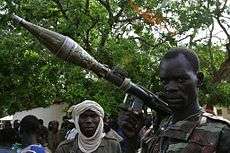
On 15 March 2003, while Patassé was abroad, rebels moved into Bangui and installed their commander, General François Bozizé, as president. Bozizé has since been elected President in an election considered by observers to be fair and free.
Patassé has been found guilty of major crimes in Bangui and CAR has brought a case to the International Criminal Court against him and Jean Pierre Bemba from the neighbouring Democratic Republic of Congo accusing them both of multiple crimes in suppressing one of the mutinies against Patasse. Civil tranquillity has yet to be established and parts of the country remain out of government control. The UN continues to maintain a peace building mission in Bangui.
Despite these shortcomings, and his promise to step down at the end of the transition, Bozizé contested the 13 March 2005 presidential elections in which all of the leading opposition candidates were allowed to run except for Patassé. Bozizé won on the second run-off round on 8 May 2005, defeating Martin Ziguélé, who ran on the ticket of the MLPC, the former ruling party. The National Elections Commission declared Bozizé the winner with 64.6 percent of the vote to 35.4 percent for Ziguélé. The election was generally considered to be fair, although the absence of Patassé cast a shadow over the legitimacy of the process.
After Bozizé seized power in 2003, the Central African Republic Bush War began with the rebellion by the Union of Democratic Forces for Unity (UFDR), led by Michel Djotodia.[19] This quickly escalated into major fighting during 2004.[20] The UFDR rebel forces consisted of three allies, the Groupe d'action patriotique pour la liberation de Centrafrique (GAPLC), the Convention of Patriots for Justice and Peace (CPJP), the People's Army for the Restoration of Democracy (APRD), the Movement of Central African Liberators for Justice (MLCJ), and the Front démocratique Centrafricain (FDC).[21]
On 8 May 2005, Bozizé gained yet a further victory when his coalition, Convergence Kwa Na Kwa, won 42 parliamentary seats in the legislative run-off vote. The MLPC came in second with 11 seats while the RDC won only eight seats. The remaining seats were won by independents or by smaller parties. In June later that year, the African Union (AU) lifted sanctions against the country, which had been applied after the 2003 coup.
In early 2006, Bozizé's government appeared stable. However, Patassé, who was living in exile in Togo, could not be ruled out as a leader of a future uprising. His supporters reportedly were joining or were prepared to join rebel movements in belief that their leader was still the rightful head of state of the country. Further, members of Kolingba's Yakoma tribe in the south posed a potential threat to Bozizé's government because of their widespread boycott of the second round of the legislative elections. Members of the Yakoma dominate the army.
On 13 April 2007, a peace agreement between the government and the UFDR was signed in Birao. The agreement provided for an amnesty for the UFDR, its recognition as a political party, and the integration of its fighters into the army.[22][23] Further negotiations resulted in an agreement in 2008 for reconciliation, a unity government, and local elections in 2009 and parliamentary and presidential elections in 2010.[24] The new unity government that resulted was formed in January 2009.[25]
2012–2014: Civil War
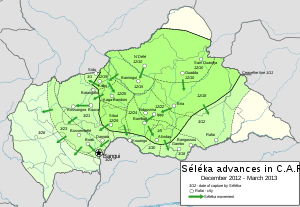
In late 2012, a coalition of old rebel groups under new name of Séléka renewed fighting. Two other, previously unknown groups, the Alliance for Revival and Rebuilding (A2R) and the Patriotic Convention for Saving the Country (CPSK) also joined the coalition, as well as the Chadian group FPR,.[26] On 27 December 2012, CAR President Francois Bozizé requested international assistance to help with the rebellion, in particular from France and the United States. French President François Hollande rejected the plea, saying that the 250 French troops stationed at Bangui M'Poko International Airport are there "in no way to intervene in the internal affairs".[27]
On 11 January 2013, a ceasefire agreement was signed Libreville, Gabon. The rebels dropped their demand for President François Bozizé to resign, but he had to appoint a new prime minister from the opposition party by 18 January 2013.[28] On 13 January, Bozizé signed a decree that removed Prime Minister Faustin-Archange Touadéra from power, as part of the agreement with the rebel coalition.[29] On 17 January, Nicolas Tiangaye was appointed Prime Minister.[30]
On 24 March 2013, rebel forces heavily attacked the capital Bangui and took control of major structures, including the presidential palace. Bozizé's family fled across the river to the Democratic Republic of the Congo[31] and then to Yaounde, the capital of Cameroon where he has been granted temporary refuge.[32] Séléka leader Michel Djotodia declared himself President. Djotodia said that there would be a three-year transitional period and that Tiangaye would continue to serve as Prime Minister.[33] Djotodia promptly suspended the constitution and dissolved the government, as well as the National Assembly.[34] He then reappointed Tiangaye as Prime Minister on 27 March 2013.[35] Top military and police officers met with Djotodia and recognized him as President on 28 March 2013.[36] Catherine Samba-Panza assumed the office of interim president on 23 January 2014.
2015–present: Civil War
By 2015, there was little government control outside of the capital, Bangui.[37] The dissolution of Seleka led to ex-Seleka fighters forming new militia that often fight each other.[37] The rebel leader Noureddine Adam declared the autonomous Republic of Logone on 14 December 2015.[38] Peacekeeping largely transitioned from the ECCAS led MICOPAX to the AU led MISCA to the UN led MINUSCA while the French peacekeeping mission was known as Operation Sangaris.
Armed entrepreneurs had carved out personal fiefdoms in which they set up checkpoints, collect illegal taxes, and take in millions of dollars from the illicit coffee, mineral, and timber trades.[37] By 2017, more than 14 armed groups vied for territory, notably four factions formed by ex-Séléka leaders who control about 60% of the country's territory.[39] With the de facto partition of the country between ex-Séléka militias in the north and east and Antibalaka militias in the south and west, hostilities between both sides decreased[40] but sporadic fighting continued.[41][42] In February 2016, after a peaceful election, the former Prime Minister Faustin-Archange Touadéra was elected president. In October 2016, France announced that it was ending its peacekeeping mission in the country, Operation Sangaris and largely withdrew its troops, saying that the operation was a success.[43]
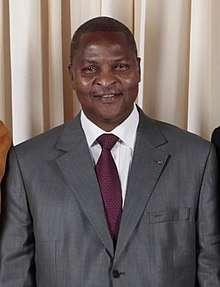
Tensions erupted in competition between Ex-Seleka militias arising over control of a goldmine in November 2016, where MPC[44] and the FPRC coalition which incorporated elements of their former enemy, the Anti-balaka,[45] attacked UPC.[46][47] The violence is often ethnic in nature with the FPRC associated with the Gula and Runga people and the UPC associated with the Fulani.[40] Most of the fighting was in the centrally located Ouaka prefecture, which has the country's second largest city Bambari, because of its strategic location between the Muslim and Christian regions of the country and its wealth.[44] The fight for Bambari in early 2017 displaced 20,000.[48][47] MINUSCA made a robust deployment to prevent FPRC taking the city and in February 2017, Joseph Zoundeiko, the chief of staff[49] of FPRC who previously led the military wing of Seleka, was killed by MINUSCA after crossing one of the red lines.[47] At the same time, MINUSCA negotiated the removal of Darassa from the city. This led to UPC to find new territory, spreading the fighting from urban to rural areas previously spared. Additionally, the thinly spread MINUSCA relied on Ugandan as well as American special forces to keep the peace in the southeast as they were part of a campaign to eliminate the Lord's Resistance Army but the mission ended in April 2017.[45] By the latter half of 2017, the fighting largely shifted to the Southeast where the UPC reorganized and were pursued by the FPRC and antibalaka with the level of violence only matched by the early stage of the war.[50][51] About 15,000 people fled from their homes in an attack in May and six U.N. peacekeepers were killed - the deadliest month for the mission yet.[52] In June 2017, another ceasefire was signed in Rome by the government and 14 armed groups including FPRC but the next day fighting between an FPRC faction and antibalaka militias killed more than 100 people.[53] In October 2017, another ceasefire was signed between the UPC, the FPRC, and anti-balaka groups and FPRC announced Ali Darassa as coalition vice-president but fighting continued afterward.[50] By July 2018, FPRC, now headed by Abdoulaye Hissène and based in the northeastern town of Ndélé, had troops threatening to move onto Bangui.[54]
In Western CAR, another rebel group, with no known links to Seleka or Antibalaka, called "Return, Reclamation, Rehabilitation" (3R) formed in 2015 reportedly by self-proclaimed[55] general Sidiki Abass, claiming to be protecting Muslim Fulani people from an Antibalaka militia led by Abbas Rafal.[55][56] They are accused of displacing 17,000 people in November 2016 and at least 30,000 people in the Ouham-Pendé prefecture in December 2016.[56] In Northwestern CAR around Paoua, fighting since December 2017 between Revolution and Justice (RJ) and Movement for the Liberation of the Central African Republic People (MNLC) displaced around 60,000 people. MNLC, founded in October 2017,[57] was led by Ahamat Bahar, a former member and co-founder of FPRC and MRC, and is allegedly backed by Fulani fighters from Chad. The Christian[58] militant group RJ was formed in 2013, mostly by members of the presidential guard of former President Ange Felix Patassé, and were composed mainly of ethnic Sara-Kaba.[59] While both groups had previously divided the territory in the Northwest, tensions erupted after the killing of RJ leader, Clément Bélanga,[60] in November 2017.[61]
References
- The History of Central and Eastern Africa, Amy McKenna, 2011, pg. 4
- The History of Central and Eastern Africa, Amy McKenna, 2011, pg. 5
- Methodology and African Prehistory by, UNESCO. International Scientific Committee for the Drafting of a General History of Africa, pg. 548
- UNESCO World Heritage, Les mégalithes de Bouar, https://whc.unesco.org/en/tentativelists/4003/
- Eggert, Manfred (2014). "Early iron in West and Central Africa". In Breunig, P (ed.). Nok: African Sculpture in Archaeological Context. Frankfurt, Germany: Africa Magna Verlag Press. p. 55.
- Eggert, Manfred (2014). "Early iron in West and Central Africa". In Breunig, P (ed.). Nok: African Sculpture in Archaeological Context. Frankfurt, Germany: Africa Magna Verlag Press. pp. 53–54.
- Zangato, E. (2007) Les Ateliers d’Oboui: Premières Communautés Métallurgistes dans le Nord-Ést du Centrafrique. Paris: Editions Recherche sur les Civilisations (ERC).
- Zangato, E. and Holl, A.F.C. (2010) ‘On the iron front: new evidence from Central Africa’, Journal of African Archaeology 8:7-23.
- Clist, B. (2012) Vers une réduction des prejugés et la fonte des antagonisms: un bilan de l’expansion de la métallurgie du fer en Afrique sud-Saharienne, Journal of African Archaeology 10:71-84.
- The History of Central and Eastern Africa, Amy McKenna, 2011, pg. 10
- "Central African Republic History, Language and Culture". www.worldtravelguide.net. Archived from the original on 12 October 2016. Retrieved 11 October 2016.
- Central Africa Republic Timeline -- Part 1: From Prehistory to Independence (13 August 1960), A Chronology of Key Events in Central Africa Republic, By Alistair Boddy-Evans, About.com, http://africanhistory.about.com/od/car/l/bl-CAR-Timeline-1.htm
- "Central African Republic". Encyclopædia Britannica.
- "Central African Republic Time Line Chronological Timetable of Events - Worldatlas.com". www.worldatlas.com. Retrieved 1 February 2019.
- Central African Republic Investment and Business Guide Volume 1 Strategic and Practical Information (World Business and Investment Library). Ibp Usa. 2016. ISBN 1514529149.
- French Colonies – Central African Republic. Discoverfrance.net. Retrieved on 6 April 2013.
- Central African Republic: The colonial era – Britannica Online Encyclopedia. Britannica.com. Retrieved on 6 April 2013.
- Blair, W. Granger (13 July 1960). "3 More Nations Gain Freedom Through Pacts Signed by France; Congo, Central African and Chad Republics Are Given Sovereignty in Paris". The New York Times.
- Hancock, Stephanie (30 August 2007). "Feature - Bush war leaves Central African villages deserted". ReliefWeb. Reuters. Retrieved 26 December 2012.
- "Raid on CAR town 'leaves 20 dead'". BBC News. 23 December 2004. Retrieved 26 December 2012.
- "Central African Republic: Rebels Call for Dialogue After Capturing Key Town". AllAfrica.com. IRIN. 2 November 2006. Retrieved 26 December 2012.
- "Central African Republic: Concern As Civilians Flee, Government Denies Rebel Capture of Third Town". AllAfrica.com. IRIN. 13 November 2006. Retrieved 26 December 2012.
- "Central African Republic, rebels sign peace deal". USA Today. Associated Press. 13 April 2007. Retrieved 26 December 2012.
- "CAR president dissolves government, vows unity". Taipei Times. Agence France-Presse. 20 January 2009. Retrieved 26 December 2012.
- "Touadera names rebels in new Central African Republic govt". Google News. Agence France-Presse. 19 January 2009. Retrieved 26 December 2012.
- "Le FPR soutient l'UFDR dans son combat contre le Dictateur Bozizé" (Press release). FPR. 18 December 2012. Retrieved 2 January 2013.
- CAR leader appeals for help to halt rebel advance (The Daily Star Lebanon)
- Sayare, Scott (11 January 2013). "Rebel Coalition in Central African Republic Agrees to a Short Cease-Fire". The New York Times. Retrieved 12 January 2013.
- "Prime minister booted from job in Central African Republic, part of peace deal with rebels". The Washington Post. 13 January 2013. Retrieved 15 January 2013.
- Patrick Fort, "Tiangaye named Central African PM, says 'hard work' begins", Agence France-Presse, 17 January 2013.
- "Central African Republic capital falls to rebels, Bozizé flees". Reuters. 24 March 2013. Retrieved 24 March 2013.
- "CAR president seeks refuge in Cameroon - Africa". Al Jazeera English. 25 March 2013. Retrieved 27 March 2013.
- "C.African Republic rebel chief to name power-sharing government" Archived 16 April 2013 at Archive.today, Reuters, 25 March 2013.
- "CAR rebel head Michel Djotodia 'suspends constitution'". BBC News. 25 March 2013. Retrieved 26 March 2013.
- "Centrafrique: Nicolas Tiangaye reconduit Premier ministre", AFP, 27 March 2013 (in French).
- Ange Aboa, "C.African Republic army chiefs pledge allegiance to coup leader" Archived 1 April 2013 at the Wayback Machine, Reuters, 28 March 2013.
- "One day we will start a big war". Foreign Policy. Retrieved 13 February 2017.
- "Central African rebel leader declares autonomous republic". Retrieved 16 December 2015.
- "Dangerous Divisions: The Central African Republic faces the threat of secession". Enough Project. 15 February 2017. Retrieved 1 March 2017.
- "Central African Republic: What's gone wrong?". IRIN. 24 February 2017. Retrieved 26 February 2017.
- "CAR violence rises: 'They shot my children and husband'". Al Jazeera. 12 February 2018. Retrieved 15 April 2018.
- "CAR: Four things to know about the conflict in the Central African Republic". MSF. 10 April 2018. Retrieved 15 April 2018.
- "French Peacekeepers Pull Out as New Violence Erupts in the Central African Republic". foreign policy magazine. 1 November 2016. Retrieved 3 November 2016.
- "The battle of Ouaka in Central African Republic". LaCroix International. 27 February 2017. Retrieved 27 February 2017.
- Kleinfeld, Philip (18 May 2017). "Rebel schism drives alarming upsurge of violence in Central African Republic". Irin news. Retrieved 18 May 2017.
- "Central African Republic: Executions by rebel group". Human Rights Watch. Retrieved 17 February 2017.
- "U.N. 'KILLS REBEL COMMANDER' IN CENTRAL AFRICAN REPUBLIC AIRSTRIKES". Retrieved 14 February 2017.
- "U.N. air strikes in Central African Republic kill several: militia". Reuters. Retrieved 14 February 2017.
- "CAR crisis: Meeting the rebel army chief". BBC News. 29 July 2014.
- "CAR refugees fleeing war suffer in Congo". Irin News. 30 October 2017. Retrieved 26 November 2017.
- "Red Cross: 115 bodies found in CAR's Bangassou". Aljazeera. 17 May 2017. Retrieved 18 May 2017.
- "Red Cross finds 115 dead in Central African Republic town". ABC. 17 May 2017. Archived from the original on 17 May 2017. Retrieved 18 May 2017.
- "Bodies Strewn Across Town After Central African Republic Clashes". Bloomberg. 24 June 2017. Retrieved 8 July 2017.
- "Central African Republic: The way of the warlord". France 24. 13 July 2018. Retrieved 30 July 2018.
- "Central African Republic: Mayhem by New Group". Human Rights Watch. 20 December 2016. Retrieved 28 February 2017.
- "Newly formed 3R rebel group inflicts horrors in CAR: UN". Al jazeera. 23 December 2016. Retrieved 28 February 2017.
- "Honderden mensen op de vlucht voor geweld in Centraal-Afrikaanse Republiek". DeMorgan. 31 December 2017. Retrieved 18 January 2018.
- "CAR Gets First Building Block in New National Army". Voice of America. 26 December 2016. Retrieved 18 January 2018.
- "Armed groups in CAR". Irinnews. 17 September 2014. Retrieved 18 January 2018.
- "Centrafrique : au moins 25 000 nouveaux déplacés dans le nord-ouest". Le Monde. 9 January 2018. Retrieved 18 January 2018.
- "In Central African Republic, militia violence leaves villages devastated". AFP. 17 January 2018. Retrieved 18 January 2018.
- Maria Petringa, Brazza, A Life for Africa (2006) ISBN 978-1-425-91198-0
